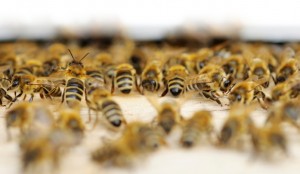11
Jun
Ontario First in North America To Limit Bee-Killing Insecticides
(Beyond Pesticides, June 11, 2015) On July 1, Ontario will become the first jurisdiction in North America to officially begin reducing the number of acres planted with neonicotinoid-coated corn and soybean seeds, an action that has been in the making since 2014. The new rules should curb the acreage planted with such seeds by 80 percent by 2017.
 The new rules will be put in place to track the sale and use of neonicotinoid-treated seeds. Additionally, for the upcoming farming season, farmers will only be allowed to use the seeds on up to 50 percent of their corn and soybean fields. Exemptions are granted only to those who can provide evidence of pest problems. In 2017, any farmer who wants to use neonicotinoid-treated seeds will have to prove the presence of pests.
The new rules will be put in place to track the sale and use of neonicotinoid-treated seeds. Additionally, for the upcoming farming season, farmers will only be allowed to use the seeds on up to 50 percent of their corn and soybean fields. Exemptions are granted only to those who can provide evidence of pest problems. In 2017, any farmer who wants to use neonicotinoid-treated seeds will have to prove the presence of pests.
“Farmers are environmental stewards of their land and this regulation will enable our province’s farmers to strengthen their approach to protecting their crops,” Agricultural Minister Jeff Leal said in a statement Tuesday.
Environment and Climate Change Minister Glen Murray said the government must take “necessary action to protect these vitally important species and the ecosystems they support from the effects of neurotoxic neonicotinoids.”
Tibor Szabo, president of the Ontario Beekeepers’ Association, said “while the new regs may not be perfect, in the end, the Ontario government did the right thing.”
“Our bees continue to die from the overuse of neonicotinoids,” said Szabo. “We hope Ontario farmers will now take it on themselves to go beyond 50 per cent reduction and only use neonicotinoids when there’s a real need to control pests.”
In the winter of 2013-2014, Ontario beekeepers lost 58 percent of the province’s honey bees, a level well above the 15 percent depletion considered sustainable for over-winter losses.
The phase-out may be a challenge ”” nearly 100 percent of corn seed and 60 per cent of soybean seed sold in Ontario is currently treated with neonicotinoid insecticides.
The action stands in stark contrast to the limited steps taken by the U.S. Environmental Protection Agency (EPA) and the recent White House plan on pollinator health, which does little to address the chronic, sublethal threat of systemic, neonicotinoid pesticides. More recently, EPA released a proposal intended to create “physical and temporal space” between bees and toxic pesticides. While touted as monumental progress on bee health by the agency, the reality is that the proposal will only result in modest changes to pesticide labels. Additionally, EPA’s new rules contain only a temporary ban on foliar applications of acutely bee-toxic pesticide products, dubbed “temporary pesticide free zones” by EPA Administrator Gina McCarthy.
Despite the increasing number of studies linking neonicotinoid use with declines in bee and pollinator health and EPA’s own study that outlines the lack of benefits associated with the use of soybean seed treatments, the U.S. continues to lag behind Canada, Europe, and other countries that have taken decisive steps to limit the use of neonicotinoids.
Beyond Pesticides has long advocated a regulatory approach that prohibits high hazard chemical use and requires alternative assessments. We suggest an approach that rejects uses and exposures deemed acceptable under risk assessment calculations, and instead focuses on safer alternatives that are proven effective, such as organic agriculture, which, of course, prohibit the use of neonicotinoids. See how you can Bee Protective.
Source: Toronto Star
All unattributed positions and opinions in this piece are those of Beyond Pesticides.










